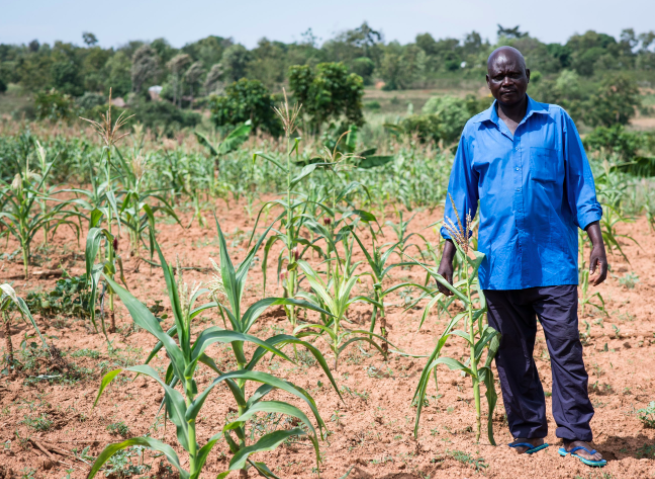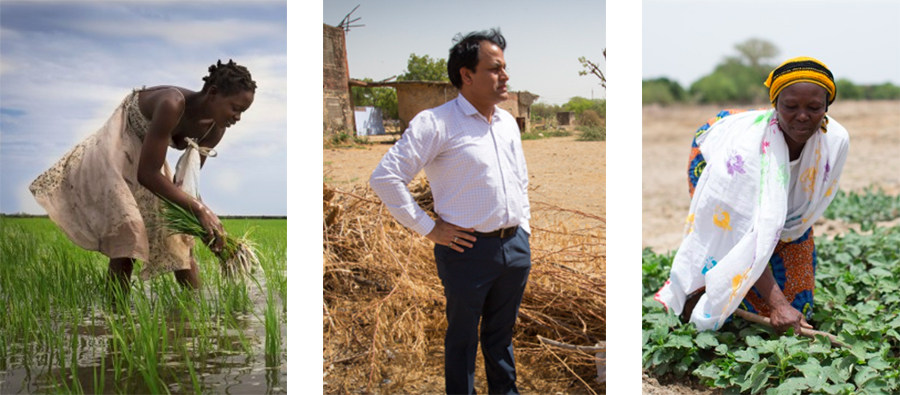As climate negotiations continue at COP23 in Bonn, Farming First takes a look at 10 stories of climate-smart agriculture in action in this latest supporter spotlight. Find out how Farming First supporters are helping farmers grow more, adapt to changing weather patterns and minimise their own carbon footprints.
1. WINnERS: Sharing Risk Through Innovative Insurance
WINnERS (Weather Index based Risk Services) is working to develop state-of-the-art weather and climate modelling technology to measure the risk exposure that retailers, buyers, banks and smallholder farmers will face in the future. This information is then integrated into agricultural insurance contracts that share risk between the various actors of a particular supply chain. Instead of having only farmers as the insurance policyholders, this means that everyone – buyers, banks, and producers – all take on some of the risk inherent in farming. So if it rains too much, not enough, or not at the right times, everyone is protected. Read more >>
2. Chemonics: Taking CSA Products to the Farmer
In recent years, persistent drought and unpredictable rainy seasons in Uganda have resulted in reduced crop yields and crop failure, pest prevalence, and increased post-harvest losses, threatening both livelihoods and food security. Chemonics is working with Feed the Future to train a network of village agents in climate-smart agriculture (CSA) practices, which the agents in turn promote to farmers. Village agents provide extension, inputs, and other products and services to farmers to help them increase the quantity and quality of their yields. Example CSA products include certified drought-resistant and fast-maturing seed varieties, micro-irrigation kits, and herbicide for conservation tillage. As of 2016, this project had enabled more than 150,000 farmers to adopt climate-resilient technologies. Read more >>
3. Access Agriculture: A Video Library for Smart Farming
Access Agriculture hosts “AgTube”, a library of videos filmed by farmers, for farmers in over 30 languages. Browse solutions for climate change in the search box. This video gives examples of water harvesting, on-farm trees, intercropping and soil conservation as ways for farmers to build resilience to changing weather patterns. Read more >>
4. Self Help Africa: Transforming the Village Where Nothing Grows
Temperatures in Burkina Faso can soar above 50 degrees. Almost nothing is able to grow in this extreme heat, which is continuing to rise. With the support of Self Help Africa, one women’s group in Gometenga village sees hope. They are being trained to grow vegetables, to irrigate their crops from a new well, and keep out grazing livestock. “If production is good, there will be something in the village for my son to come back from Ivory Coast to work on,” says Kangabega Ayesto. “It will show him that there are opportunities in Gomtenga to earn a living”. Read more >>
5. IFA: The Brazilian Agronomist Reducing the Emissions of Tropical Agriculture
Ethanol powers 40% of vehicles in Brazil and the market is expected to continue to rise. To make the transition from fossil fuels to biofuel a sound move both economically and environmentally, we need to keep sugarcane’s production emissions in check. An innovative use of fertilizer can reduce nitrous oxide emissions associated with sugarcane production by up to 95% Dr. Heitor Canterella of São Paulo recently won the IFA Norman Borlaug Award for his work in this area, to lower the emissions of tropical agriculture. Read more >>
6. Farm Africa: New Weather Stations in Ethiopia to Take Bite out of Climate Shocks
A set of new automated weather stations has been installed in Ethiopia to help pastoralist and agro-pastoralist communities respond better to recurring climate shocks. A total of 25 solar-powered automated weather stations have been installed across Afar, Somali and SNNP regions. The stations supply localised, accurate and timely data to relevant government agencies and local communities, which will help communities predict the availability of water and grass for their livestock to graze on and allow government agencies to pre-empt and monitor extreme weather events. “The information we are listening to now is very useful. It is exact.” commented Ato Endashaw Lole, a local resident. “If the radio says there will be heavy rain, there will be heavy rain — and we’ll be ready for it”. Read more >>

7. CropLife International Food Hero Series: Tackling Climate Change and Soil Salinity in India
Dr. Ashwani Pareek received a call from his father to say that in his hometown of Sambhar Village in Rajasthan India, farmers were no longer able to grow crops due to increased soil salinity and climate change. Together with his wife, Dr. Sneh Latah Singla-Pareek, he is now working on breeding plants that can still thrive in these extreme conditions. Farmers that are struggling tell Dr. Pareek they would welcome drought-tolerant, salt-tolerant crops, in order to feed their families and continue their legacy of generations of farming. Read more >>
8. One Acre Fund: A Climate-Smart Strategy for Farming in Africa
One Acre Fund is in the process of building Africa’s “largest multi-layer climate resilience shield” for smallholders. Guided by three principles: adaptation, mitigation and sustainable intensification, their work seeks to help farmers overcome the challenges of climate change. Interventions include crop insurance, and increasing crop diversity to ensure farmers can hedge against climate shocks. In recognition of the importance of healthy soils for increased water retention and building resilience to drought, One Acre Fund also provides ongoing training to farmers on integrated soil fertility management, providng products that build long-term soil health. Read more >>

Moses Odoli stands among his drought-affected maize crops in Western Kenya. Image credit: One Acre Fund
9. IFDC: Micronutrients to Mitigate Drought Stress
According to a scientific publication released this year by IFDC and VFRC, micronutrients provide multiple benefits to crops, such as boosting crop performance under adverse environmental conditions. In particular, the paper demonstrates the effects of micronutrients in mitigating drought stress in soybean. Treatment of the plants with micronutrients mitigated the reduction of nutrient uptake under drought conditions. Nitrogen uptake was significantly increased. Similarly, zinc uptake and grain zinc content were significantly enhanced by the formulations. Therefore, agronomic fortification of zinc in food crops may be an effective strategy for increasing the nutritional quality of edible produce under water limiting conditions. Read more >>
10. AgDevCo: Bringing Irrigation to Sugarcane Production in Malawi
The arid land in Southern Malawi has forced communities into perpetual poverty and driven farmers out of business. An investment from AgDevCo into the Phata sugar co-operative in Malawi made it possible to irrigate land for growing sugarcane. “I’m one of many people in the nearby village, who are employed by the Phata co-operative to harvest sugar cane,” says Alice. “In the past, if I was lucky, I would get seasonal work but even that depended on the rain. Crops are now grown on irrigated land and there is work year-round. I have a steady income, which goes a long way to support my extended family.” Read more >>
For more stories on climate-smart agriculture, visit our climate portal: http://www.farmingfirst.org/climate



